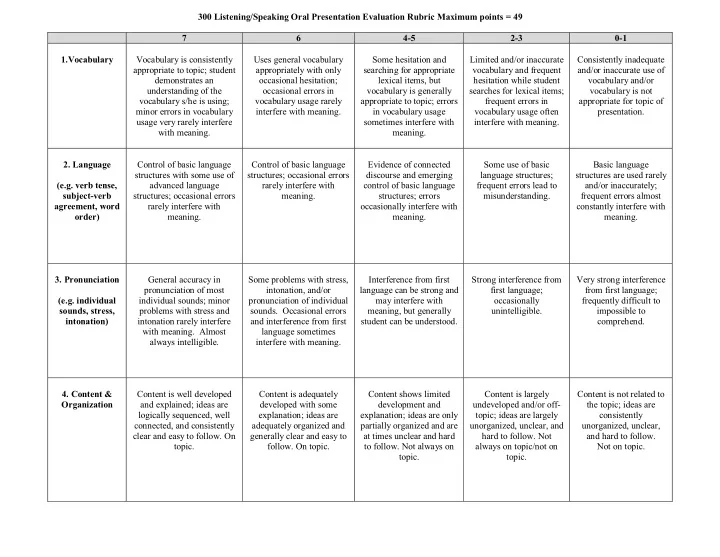

300 Listening/Speaking Oral Presentation Evaluation Rubric Maximum points = 49 7 6 4-5 2-3 0-1 1.Vocabulary Vocabulary is consistently Uses general vocabulary Some hesitation and Limited and/or inaccurate Consistently inadequate appropriate to topic; student appropriately with only searching for appropriate vocabulary and frequent and/or inaccurate use of demonstrates an occasional hesitation; lexical items, but hesitation while student vocabulary and/or understanding of the occasional errors in vocabulary is generally searches for lexical items; vocabulary is not vocabulary s/he is using; vocabulary usage rarely appropriate to topic; errors frequent errors in appropriate for topic of minor errors in vocabulary interfere with meaning. in vocabulary usage vocabulary usage often presentation. usage very rarely interfere sometimes interfere with interfere with meaning. with meaning. meaning. 2. Language Control of basic language Control of basic language Evidence of connected Some use of basic Basic language structures with some use of structures; occasional errors discourse and emerging language structures; structures are used rarely (e.g. verb tense, advanced language rarely interfere with control of basic language frequent errors lead to and/or inaccurately; subject-verb structures; occasional errors meaning. structures; errors misunderstanding. frequent errors almost agreement, word rarely interfere with occasionally interfere with constantly interfere with order) meaning. meaning. meaning. 3. Pronunciation General accuracy in Some problems with stress, Interference from first Strong interference from Very strong interference pronunciation of most intonation, and/or language can be strong and first language; from first language; (e.g. individual individual sounds; minor pronunciation of individual may interfere with occasionally frequently difficult to sounds, stress, problems with stress and sounds. Occasional errors meaning, but generally unintelligible. impossible to intonation) intonation rarely interfere and interference from first student can be understood. comprehend. with meaning. Almost language sometimes always intelligible. interfere with meaning. 4. Content & Content is well developed Content is adequately Content shows limited Content is largely Content is not related to Organization and explained; ideas are developed with some development and undeveloped and/or off- the topic; ideas are logically sequenced, well explanation; ideas are explanation; ideas are only topic; ideas are largely consistently connected, and consistently adequately organized and partially organized and are unorganized, unclear, and unorganized, unclear, clear and easy to follow. On generally clear and easy to at times unclear and hard hard to follow. Not and hard to follow. topic. follow. On topic. to follow. Not always on always on topic/not on Not on topic. topic. topic.
7 6 4-5 2-3 0-1 4. Fluency Speech sustained throughout Speech sustained most of Some sustained speech; Little sustained speech; Little to no sustained with few non-nativelike the time; some hesitation few or no incomplete speech is halting and speech; frequent pauses (e.g. pace, flow, pauses. Smooth and but manages to continue thoughts. Speech is uneven with long pauses and halting rhythm cause ease of speaking) rhythmic patterns rarely and complete thoughts. choppy and/or slow with or incomplete thoughts. almost constant interfere with intelligibility. Some difficulty with frequent pauses. interference with smoothness & rhythmic intelligibility. patterns, which causes occasional interference with intelligibility. Volume Student speaks clearly and S tudent’s voice is clear and Student occasionally Student often speaks Student consistently volume is loud enough to be volume is usually loud speaks too quietly to be quietly and audience mumbles and/or speaks heard by all audience enough to be heard by all heard by all audience members have difficulty too quietly to be heard members throughout audience members. members. hearing presentation. by audience members. presentation. Eye contact Student consistently makes Student makes eye contact Student makes some eye Student makes little eye Student makes little to eye contact with all audience with most audience contact, but not with all contact with audience no eye contact with members. members. audience members. members. audience members. Gestures & Student consistently uses Student uses appropriate Student uses appropriate Student rarely uses Student does not use movement movement and gestures gestures and movement in gestures and movement in appropriate gestures gestures and/or appropriately. most parts of presentation. some parts of presentation. and/or movement. movement appropriately. Student sometimes has Student consistently has Confidence Student consistently has Student has good posture poor posture and/or Student rarely has poor posture and/or good posture and appears and appears confident for appears nervous in some appropriate posture and/or appears nervous relaxed and confident. most of presentation. parts of presentation. appears nervous for most throughout presentation. of presentation. 6. Visual Aids Visuals are consistently Visuals are clear and Visuals are usually clear Visuals are sometimes Visuals are consistently clear, interesting, and well- related to the topic; visuals and related to the topic; unclear and/or unrelated unclear and/or unrelated organized; visuals generally add to audience’s visuals sometimes add to to the topic; visuals rarely to the topic; visuals do consistently add to understanding of the topic. audience’s understanding add to audience’s not add to audience’s audience's understanding of of the topic. understanding of the understanding of topic. the topic. topic. 7. Timing Student spoke an equal Student a little less than the Student spoke less than the Student spoke Student spoke for a very amount of time as the other other group members other group members significantly less than the little amount of time group members other group members
Recommend
More recommend